Seeing and Listening Differently: An exchange with the documentary filmmaker, Katy Léna Ndiaye
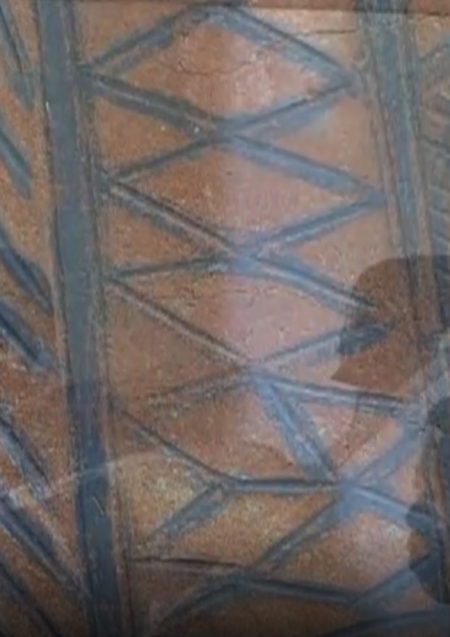
The French version of this discussion is available here.
Traces, Empreintes de femmes (Traces, Women’s Imprints, 2003)
Albertine Fox: In this film, as the title indicates, there seems to be a profound connection between the female body, female identity, and the landscape, by which I mean the physical landscape in its materiality and textural beauty. The relationship is very symbiotic. It differs from notions of property and the control of territory. The women’s faces and bodies are inscribed visually in the landscape via the imagery, blending with its surfaces and textures. What are your thoughts on the relationship between the women, the landscape, and the image in this film?
Katy Léna Ndiaye: In terms of its structure, composition, and aesthetic language, Traces, Women’s Imprints [hereafter Traces] is more an ‘object’ than a documentary in the conventional sense. In the opening shots, the landscape takes precedence. Then, I situate the participants in their particular local context, which is inevitably at a distance from our own — we, the spectators. The distance between us, at once geographical and cultural, can then be eradicated using the tools of conversation and the face-to-face encounter (‘being looked at/looking back’), filmed largely via close-up shots. Thereafter, when the conversation dries up, temporarily or permanently, our focus returns to the walls and the spaces these women inhabit.
The notion of territory, in terms of a gendered demarcation between a man’s space (and place) and a woman’s is absent. I didn’t film the women with the intention of excluding men. My approach was very gentle, very simple. I wanted to sit down, and sit my camera down, in front of these women – my fellow human beings, my fellow women. I filmed their words, their worlds, and brought them to the audience. These face-to-face encounters, filmed at close range, invite us to consider what is not shown, a thought that resonates with the landscape shots from the start. They prompt us to consider how ‘they’ [the men] have little significance in this context. My filmed exchanges with these women urge us to consider the extent to which we can identify with the stories they tell – the possibility of recognising ourselves and each other in the words of ‘These Others’. Is it possible for us to conceive ‘collectively’ of our status as women and men in society?
AF: Could one say that this filmic process of ‘giving attention’ to the words and individual features of these women, serves not only to humanise the representation of ‘African women’ on screen, as you’ve suggested elsewhere, but could it also serve as a form of resistance against the homogenising effects of Western-dominated media imperialism?
KLN: The word ‘humanise’ bothers me. It’s not the right word. I haven’t ‘humanised’ these women, because they are my and our fellow human beings. At the same time, they’re different from you and me. In this film and in my later films, my cinema positions itself in opposition to a picture-postcard representation of life in Africa, and against the idea of it being an object in need of ‘humanising’. I film subjects: men and, in this case, women. But yes, you’re right that I try to foster an alternative relationship whereby the spectator is prevented from merely consuming the images offered up. The spectator is just as involved as the filmed participant, who looks at us, addresses us, and compels us to see and listen differently. That’s my hope. The spectator must reconsider their relationship to the filmed subject, to listen to her, and see her, as someone like them — their fellow human being. This dynamic is sketched out in Traces, but it is more discernible in Waiting For Men.
AF: In this film, the women are the creators. They express themselves artistically: they produce murals, they work collaboratively with other women to build and refurbish their homes. They are the storytellers who construct their own narrative. Their presence is at the centre of the image and it cannot be diminished because it permeates the surrounding landscape. I want to ask you about the soundtrack, which is a striking part of the film. For me, the women’s presence becomes a sort of rhythm that saturates the visuals and vibrates with the viscous textures that fill the screen. The women’s gestures become a compositional musical material. Could the soundtrack be construed as another wall in the film? Another creative surface?
KLN: Yes, you are right. And I’ll return here to what I explained earlier. This film is an object where sound and image are in dialogue with each other. The soundtrack plays a crucial role. I conceived it as a near-central element in the composition of the film and the Belgian jazz composer and musician, Erwin Vann, worked on the score with this idea in mind. I wanted the music to give the film and the gestures we see a contemporary dimension. The music functions almost as a character at times, while, as you’ve noted, at other times it resembles a wall on which the women – the group of female painters – express themselves. The music transforms the renovation work into a fleeting ‘performance’, an action accomplished by one or several people, instilling it with an artistic meaning.
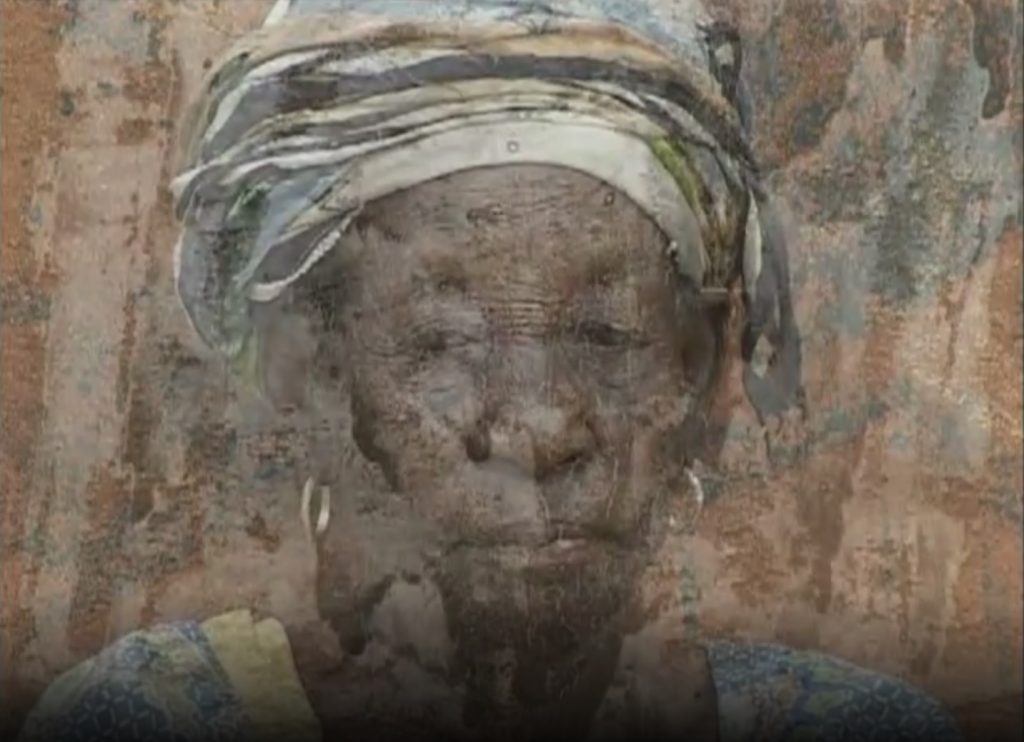
A close-up of the face of Katiga (Anetina’s grandmother) dissolves into a close-up of the wall art. The texture of her skin mixes with the texture and colours of the paint.
AF: In the interview I cited earlier, you described how the music in this film was a means of ‘shattering clichés of Africa’, and that your collaboration with Erwin Vann involved the composition of a distinctive contemporary music emanating from the ‘raw’ sounds captured on location during the shoot.
KLN: It’s not that I wanted to distance the score from traditional music, but I wanted to compare the gestures of these female artists, who express themselves via their murals (the ‘canvas’ of the walls), with the gestures of performing artists. The music, recomposed from fragments of recorded sound collected during filming, contributes to the composition of this filmic object.
AF: In the same interview, you also pointed out the following: ‘For me, these women shouldn’t only be seen as African women. The relationship between Anetina and her elders is universal.’ From your perspective, why is the idea of universality important in this context?
KLN: Here we return to something I discussed earlier: eliminate the temptation, on the spectator’s part, to exoticise, so that the relationship between Anetina and her elders, which is, after all, universal, can be seen for what it is. This is important because all too often everything proceeds as if the continent of Africa was a world apart and singular, almost like a different world.
AF: There is a moment in the film when Anetina discusses the submissiveness and enforced passivity that women must endure in a patriarchal society. We then see a potent image of a cracked mirror in a hair salon [La différence is the name of the salon]. In the cracked glass, we see the reflection of Anetina talking to the hairdresser and her client. This shot struck me as a visual expression of pain but also of resistance. An expression of the fragmentation of identity but also of creation. The women persist in their creative work, despite their circumstances. Do you see a link between this image of the cracked mirror and the meaning of Anetina’s words?
KLN: It’s exactly that. When we made the film and met Anetina, she had found herself at a crossroads in life. She had recently been through some difficult times, and she was becoming aware of the hand life had dealt her. In the sequence you’re referring to, Anetina almost emerges from childhood in front of our eyes, leaving behind the innocence that marks this period in life. She is aware of her situation but at the same time we get the impression that she will not give up. She will find the path that’s right for her, and thus her place in the world.
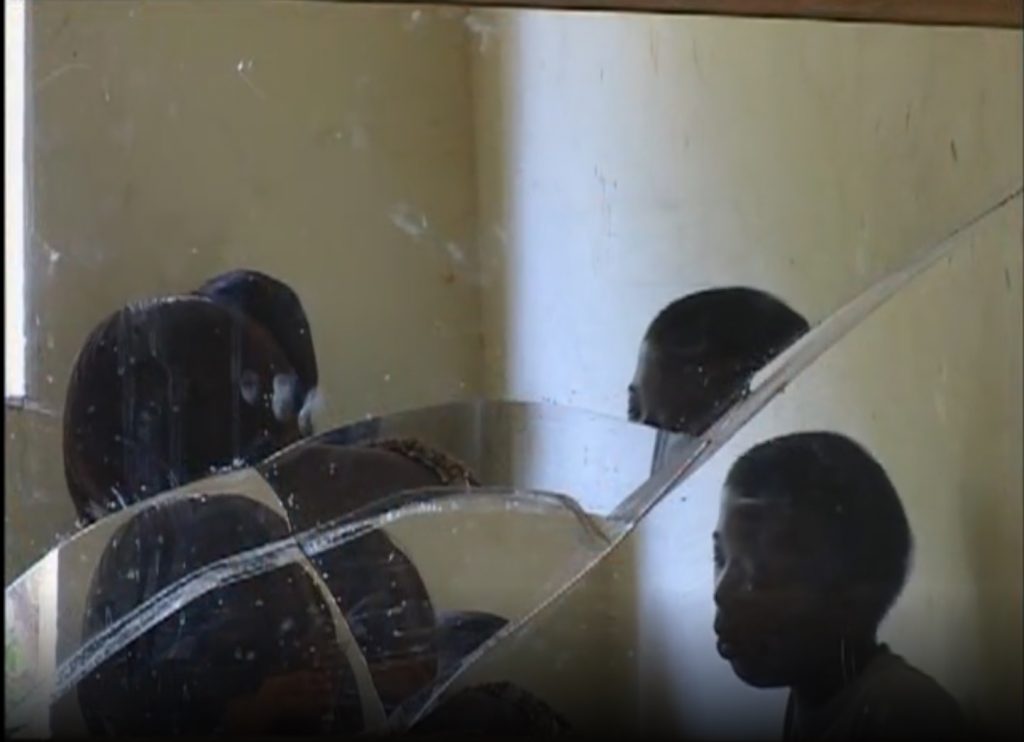
The cracked mirror in the hair salon where Anetina can be seen talking to the hairdresser and her client.
En attendant les hommes (Waiting For Men, 2007)
AF: Near the start of this film, we see shots of women walking, filmed from behind, and a little girl sitting in the doorway of her home. I wondered about the source of the words that accompany these shots, uttered via voice-over. Is this a proverb?
KLN: I gathered these words, here and there, from Khady, Massouda and Tycha, the three protagonists. They become a sort of riddle, a mysterious poem that sweeps through the film and we only come to understand its meaning at the end, in the very last shot. These words relate to many of the sequences in the film that all evoke a recurring motif… It’s hard to explain without giving away the riddle. In the film, I provide the components of a narrative structure and it’s up to the spectator to find their own way through. They must actively work to find the meaning, and this enables them to move beyond their position as a ‘consumer’ of images and sounds.
AF: When night falls, and we see the women praying, does the whispering voice we hear (off-frame) belong to Khady? This is a very intimate moment when we have access to her interior world. Why did you decide to amplify the sound of her voice in this scene?
KLN: The sound of her voice is amplified but we can’t make out what is said. We can only guess. Khady whispers her prayer, but its meaning is indecipherable. She utters these words for herself alone, and for the one to whom they are addressed. This moment contrasts with scenes when Khady, Massouda and Tycha look us straight in the eye and reveal details about their intimate desires. The prayer sequence is there to remind us of the place, the mental and cultural territory (which is that of Islam), from which the characters speak. And that contrary to popular belief, in these places too, women are and express their intimate desires. This tells us it isn’t a noteworthy or exceptional thing to behold in itself. These women are our fellow beings. When they take their turn to ask us questions, they do just that, they take our place and question us, as we did previously with them.
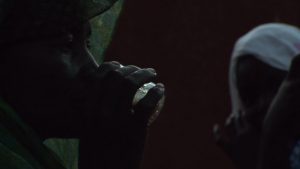
In the late evening Khady prepares herself for prayer.
AF: I have the impression that this film redefines the idea of ‘waiting’. It isn’t about waiting as such, but it reveals the creativity and receptivity of these women as they live their life in a way that suits them. The film fights against the idea of waiting (for men) as a state determined, and limited, by the presence or absence of men.
The filmmaker and writer Trinh T. Minh-ha has recently reflected on the act of walking. She connects walking to women’s struggles around the world, describing it as a ‘creative gesture’, a ‘form of resistance’, and ‘an activity for peace’. Walking can constitute ‘a mode of receptivity’ and ‘a way of apprehending the world’. I wonder if the activity of ‘waiting’ in your film could be understood in a similar way – these women don’t pass the time, so to speak, by doing things to fill time, but they create a time for themselves, their own configuration of time. How do you understand the act of waiting?
KLN: It’s not about a way of life. More than creativity, the film captures unadorned existence. The film is structured around the daily life of these women in Oualata, and around the unique temporality of their lives, over which I cast an eye. My gaze gives a rhythm to their story. What I express via the film is the following: We don’t live waiting but rather, while waiting (as the title indicates), we live. The film is about time and, therefore, the women aren’t waiting, they’re living. The men come and go, some stay, and during this time the women exist, they live. This applies to us all as human beings.
AF: When I watch and listen to the interviews, which are often followed by shots of the murals or landscape shots, I can still hear in my mind the words of the woman from the previous shot. I am still listening to her words but with a different sensibility. When you made the film, did you consider the act of listening as a practice, as a way of working? Does listening have an important place in your film?
KLN: We should think of Waiting For Men and Traces as films concerned with the gaze and with listening. The organisation of each film contributes to these core aspects. I sketch out portraits of the women in each case and allow enough time for the spectator to get to know them, to understand something about them. To achieve this, in Traces, I banished the use of camera movement, and in Waiting For Men all the shots are static, all of them. And yes, the aftermath of an interview produces a rhythm, which prolongs the conversation. The women’s words penetrate the interior world of the spectator. The questions that come up take them by surprise and force them to be active participants. They have to find an answer.
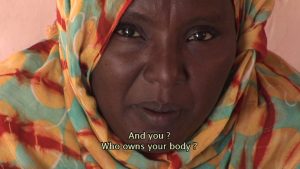

Massouda poses a question to Ndiaye and the audience; an extreme close-up follows of a woman’s pregnant belly, accompanied by the sound of a woman singing.
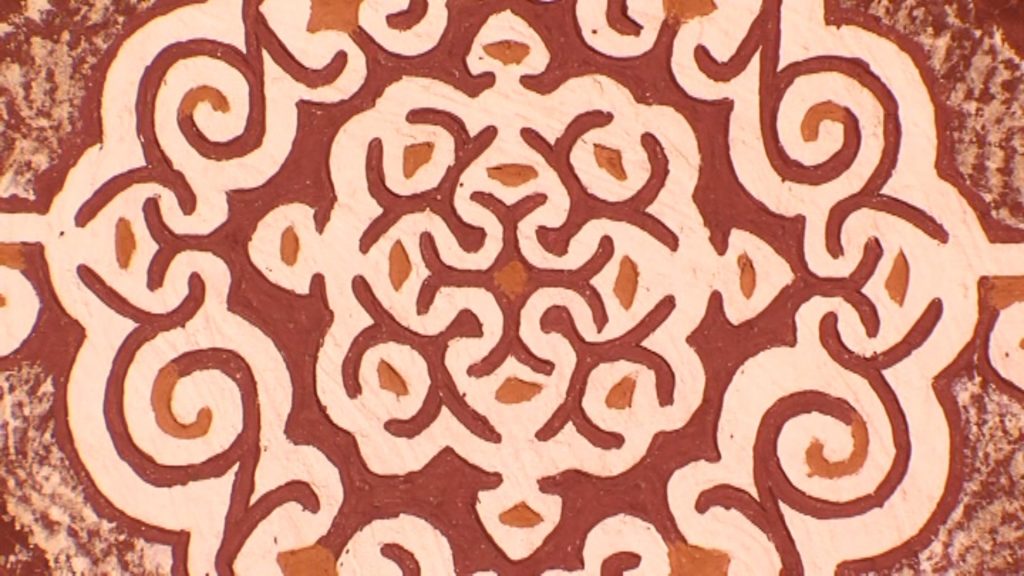
In a later sequence, a similar interview scene with Massouda unfolds, followed by another extreme close-up, but this time we see a mural instead of the female body, accompanied by the faint sound of Massouda mixing the pigment.
AF: These two films are much more than cultural or ethnographic documents because they make space for the imagination. The colours, the music, the visual and sonic textures, and the use of dissolves in Traces, create a rich imaginative space that feels almost spiritual. What do you think of this idea?
KLN: It’s a mistake to link my work to ethnography. I’m a documentary filmmaker. My work involves showing a recreated version of real life, modified by my gaze, my perspective, my own unique filmmaking style, but it is always connected to real life. As I said earlier, I try to create work that transforms the spectator and forces them to abandon their role as a consumer of ‘images from elsewhere’.
On a le temps pour nous (Time is on Our Side, 2019)
AF: Why did you decide not to use a conventional ‘face-to-face’ interviewing format in this documentary?
KLN: The techniques I use depend on the story, the subject, and the context. The idea of photographic portraiture and participant-spectator conversations in Trace and Waiting For Men required a ‘to camera’ interview style. In this later film, Smockey is a character ‘in motion’, as is his country and the events unfolding there.[1] From the first shot, Smokey is on the move and the camera moves with him. It stays by his side and follows him around. We step into his shoes to get to know him, to learn what motivates him, and this, in turn, sets the film in motion. If I had sat facing him, in a conventional face-to-face situation, Smockey would have just settled into his role as spokesperson for Balais Citoyen,[2] or he would have reverted to his persona as a rap artist, one who is well accustomed to the performance of self-representation in front of the media. By contrast, my camera is consistently positioned behind or beside him. This allows him to forget I’m there, and it allows me (us) to access the ‘other Smockey’, whose mask sometimes slips.
AF: And yet your invisible presence in this film is deeply felt. Could one describe it as a sort of listening presence?
KLN: The position of ‘beside’ is the one I was comfortable occupying in the film. I was taken aback by the riots in Burkina Faso and what they led to (I didn’t think they would bring about the fall of Compaoré). I was also surprised to learn that Smockey and the leaders of Balais Citoyen are of the same generation as me. This ‘listening presence’ that you describe encapsulates all of this. At Smockey’s side, I try (belatedly) to understand, to look deeply into things, to break through the surface. I try to grasp what lies behind the ‘media’ image of the artist/activist who is trying to bring about social change, and to understand the underlying reasons for his actions. Smockey isn’t an enemy, and this is conveyed by my listening position, established by the camera, which is never in front of him, except for right at the end of the film, just before I leave him.
AF: Do you think listening, as a silent action, can help to create a new political space?
KLN: For me, cinema is a space and a time where we are continuously learning to see differently. Moving images require that we decipher their grammar in order to understand their meaning, to understand the story, and they demand that we listen attentively.
Every filmmaker, I believe, wants their film to be an experience such that when it ends, the spectator who leaves the cinema isn’t the same person as the one who entered. I think this is also true of the filmmaker. The process of making the film transforms you just as much as, if not more so than, it transforms the public. The idea you refer to in your question, namely, the creation of a new political space, can perhaps be understood on the level of experience.
Final thoughts
AF: In your experience as a journalist and a filmmaker, who creates new cinematic ways of looking, listening, and thinking, do you think there are ingrained racial and gendered prejudices in the film and television industry in Europe?
KLN: Even if the context isn’t the same from one country to another, a general tendency can be observed in society. What happens in politics, in business, in universities, and in many other social settings, also happens in the arts sector. ‘Racialised’ (even if I don’t like this word) groups, and other minorities, don’t have access to the same opportunities, by which I mean employment opportunities, access to funding, and opportunities to make and exhibit one’s work. Why? Because the cultural providers, curators, broadcasters, and festival management, tend to represent the dominant culture. They either don’t watch our cinema at all or engage with it extremely rarely. The spaces available to us are those relinquished to us, those at the margins (too often), which offer limited chances to meet a large audience and engage in public events.
Consequently, we are denied not only the possibility of reaching and accessing other cinemas, but also of deconstructing a notion of alterity inherited from the colonial past. This past has made of the Other ‘an object’, one who is deemed incapable of being the producer of discourse, of thought, and of meaning, and this includes the possibility of producing meaning about oneself.
More often than not, these filmmakers and artists ‘rendered invisible’ reinvent dominant cinematic codes, produce a new audio-visual language, and explore new forms of representation. Quite simply, they make cinema. This leads to the blossoming of new meaning, a distinctive aesthetics, and new material to see and reflect on collectively and otherwise. This is precisely what the ‘dominant cinema’, which seems to me to be running out of steam, is finding it difficult to do.
AF: Based on your own experiences in Europe, do you think there is a tendency to restrict your films to a single ethnographic or sociological category?
KLN: Yes, sometimes at festivals labelled ‘African cinema’… It’s not that I want to discredit these festivals, since most of them facilitate wonderful encounters with the general public. But too often these spaces are the only ones that accept and welcome our films, and, in turn, the only ones that allow our work to be considered, and this reality should concern us all collectively. I want to believe this sort of ostracism will soon disappear. In any case, we are working towards this eventuality.
End
Translated by Albertine Fox in collaboration with Katy Léna Ndiaye and assisted by Chloé Laborde and Evan Grégoire-Izard.
Acknowledgements
My sincere thanks go to Katy Léna Ndiaye for her generosity and willingness to discuss her films with me. I am also grateful to Chloé Laborde (Teaching Associate, School of Modern Languages, Bristol) and Evan Grégoire-Izard (Teaching Fellow and PhD Candidate in Political Theory, CEVIPOF – Sciences Po) for their invaluable assistance with my translation queries during the final stages of editing.
[1] This documentary centres on the Burkinabe rapper, poet, and political activist Serge Bambara (aka Smockey). Find out more here: https://indigomoodfilms.com/catalogue/on-a-le-temps-pour-nous/
[2] Balais Citoyen is a grassroots political movement in Burkina Faso that opposes and protests against President Blaise Compaoré.
‘Anetina donne de l’espoir: entretien de Heike Hurst, Tahar Chikhaoui et Olivier Barlet avec Katy Léna Ndiaye à propos de Traces, empreintes de femmes’, Africiné.org, October 2003. Online at: http://www.africine.org/entretien/anetina-donne-de-lespoir/3075





